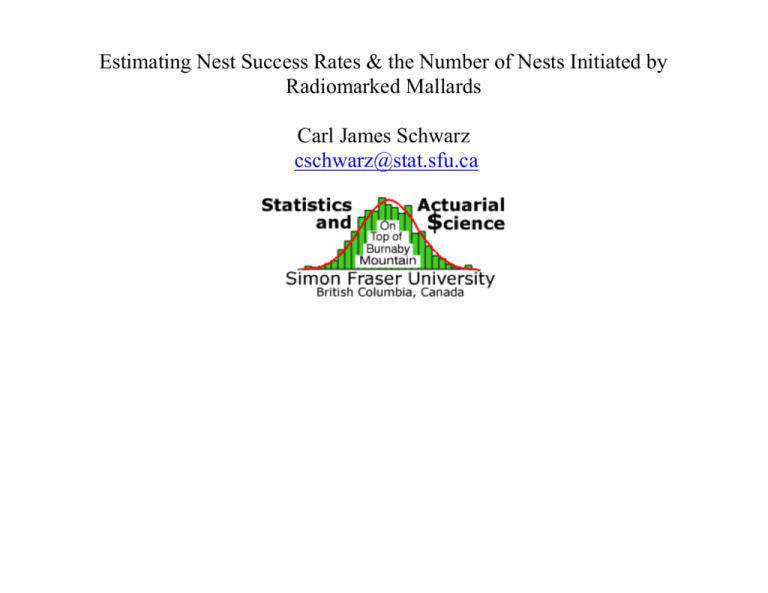2004-07-ibc-mallard
advertisement

Estimating Nest Success Rates & the Number of Nests Initiated by
Radiomarked Mallards
Carl James Schwarz
cschwarz@stat.sfu.ca
Estimating Nest Success Rates & the Number of Nests Initiated
Typical Sampling Protocol:
- search for viable nests
- follow detected nests until success or failure
- DANGER: length biased sampling
- Estimators to account for this bias:
* Mayfield (1961, 1975) method
- assumes that daily survival is constant over nesting period
Farnsworth et al (2000) – heterogeneity -> bias
Used Kaplan-Meier with staggered entry to allow variation
- measures survival from first encounter rather than initiation
Pollock and Cornelius (1988), Bromaghin and McDonald (1993)
model encounter probabilities.
Estimating Nest Success Rates & the Number of Nests Initiated
Observed number/density is an underestimate because not all nests detected
Miller and Johnson (1978), Johnson and Shaffer (1990) divided observed
successful nests/prob of sucess
N̂ MJ
xJ
Ŝ1Ŝ2 L ŜJ
- only uses successful nests and hence loss of information
Bromaghin and McDonald (1993a) provided a more general approach where
the sampling design that locates nests is also modeled.
Estimating Nest Success Rates & the Number of Nests Initiated
Our Study:
- 1993–2000, 27 study sites, Western Canada
- in 1997, 135 female mallards captured, radio tagged
- radiomarked females located 2–3 times daily - when a nest found, initiation date determined.
- nest followed until success or failure
Estimating Nest Success Rates & the Number of Nests Initiated
Statistics:
xi
Number of nests seen for the first time at age i.
ri
Number of nests that survived from age i to age i + 1.
Ri
Number of nests at risk at age i. Usually, Ri = ri–1 + xi, but
censoring possible
Age (days)
Ri
ri
1
16
12
2
26
19
3
43
40
4
64
60
+ … 21 more days of data ….
Total
1,868
1,752
xi
19
17
25
24
175
Estimating Nest Success Rates & the Number of Nests Initiated
Parameters:
N
Si
pi
i
Total number of nests initiated by the radiomarked sample.
Probability a nest survived from age i to i + 1, given the nest
survived to age i.
Probability that a nest was newly found at age i, given the nest has
survived to age i and has not been previously found.
Probability a nest was newly found at age i.
i 1
1 p1 ; 2 1 p1 S1 p2 ; i pi S j 1 p j .
j 1
Estimating Nest Success Rates & the Number of Nests Initiated
Likelihood model – 2 components
(1) How nests are found?
N
J
N xi
xi
J
J
L1
i 1 i
x1 ,..., xJ , N xi i 1
i 1
.
i 1
(2) How nests survive:
Ri ri
Ri ri
L2 Si 1 Si
.
i 1 ri
J
2J + 1 parms to fit to 2J sufficient statistics – one restriction pJ = 1
Estimating Nest Success Rates & the Number of Nests Initiated
Key Assumptions
- radiomarked birds must be representative of the overall population.
- radiomarking must not affect subsequent nesting behavior.
- newly found nests must be aged correctly.
- detection and survival probabilities will depend only on age and not on
time. For example, a nest of age i discovered on 15 May must have the
same probability of subsequent survival as a nest of age i discovered on 15
June.
- radiomarked females cannot leave the study site and nest where they are
undetectable by telemetry surveys.
- the act of finding a nest must be independent of subsequent survival.
Estimating Nest Success Rates & the Number of Nests Initiated
No closed forms except for estimator of N which takes the form:
N̂ MLE
x•
̂ •
1
̂
nests
•
,
where
J
x• xi
i 1
J
is the total number of nests observed and
J
i 1
i 1
j 1
̂ • ̂ i p̂i Ŝ j 1 p̂ j
i 1
This is a “Horvitz-Thompson” like estimator
Estimating Nest Success Rates & the Number of Nests Initiated
Summary of model fitting and parameter estimates
Upper and
N̂ lower 95%
logL K AICc AICc
Modela
(SE) CI for N
232.0
{N p3t S}
211
260 –132.6 5 275.2
0.0
(12.0)
243.4
{N p3t S2t}
216
282 –131.6 6 275.2
0.0
(16.4)
242.6
{N p S}
217
Inf –145.8 3 297.6
22.4
(15.9)
232.7
{N pt S}
212
261 –123.1 26 298.5
23.4
(12.2)
Model
237.1
214
272
averaged
(15.3)
1.91
Nests/female
1.73 2.19
(0.12)
“Mayfield”
236 178
320
w
0.505
0.495
0.000
0.000
Estimating Nest Success Rates & the Number of Nests Initiated
Model estimates from two “best” models from previous table
Estimated
Estimated detection
daily survival
rates (SE)
rates (SE)
1–3
4–6
≥7
1–10
≥11
Modela
days days days
days days
0.10
0.22 0.24
0.94 0.94
{N p3t S}
(.013) (.025) (.041) (.005) (.005)
0.10
0.21 0.24
0.93 0.94
{N p3t S2t}
(.013) (.025) (.041)
(.01) (.006)
Estimating Nest Success Rates & the Number of Nests Initiated
Summary:
- Mayfield methods can be extended to account for non-constant survival
- Mayfield methods can be extended to model nest discovery
CRUCIAL – some nests must be discovered at AGE 1!
- Mayfield-related methods do not use entire information present
Power analysis shows that can reduce number of nests by 6x using our
method!
- Goodness of fit passed for this dataset
- because of HT form, robust to heterogenous survival
- because of HT form, biased by heterogeneous discovery
- We are relatively confident that assumptions are nearly satisfied








